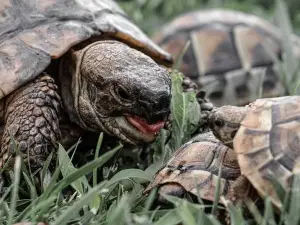
It’s natural to be concerned about your turtle’s health, this is part and parcel of being a good turtle owner and raiser. If your pet starts doing something that is out of the ordinary, if the animal’s head starts twitching, then you’d be right to be worried
This article looks into why your turtle’s head may be twitching
Table of Contents
Why is my turtle’s head twitching?
Persistent and unusual twitching of the head may lead you to think that the animal has an underlying health issue and this will understandably greatly concern you
Here are the reasons why this may be happening with your pet turtle:
Metabolic bone disease:
The twitching that you’re seeing in your pet turtle may be the result of a condition called metabolic bone disease.
This is a complex disorder that is quite common in turtles and is usually caused by improper husbandry.
Examples of improper husbandry would be feeding the animal a diet that is too high in fat, and phosphorus or feeding the animal a diet that is too low in calcium and vitamin D3. It can develop in turtles who don’t get sufficient UV light exposure.
Other signs of this condition in your pet, in addition to the turtle’s head twitching, include softened or swollen jaw and facial bones, also called rubber jaw, bumps, malformation or swelling of the skeleton or shell as well as fractures of the bones, lethargy, tremors, weakness, paralysis, soaking, twitching as other bone abnormalities
What to do:
This is quite a serious condition that needs to be treated by a vet so making an appointment with the vet as soon as possible is a must.
The vet will do bloodwork and take an x-ray to determine if your pet does have this condition,
If it is found that your pet has this condition then treatment for the disease is changing your pet’s diet, and correcting other husbandry issues like giving the animal daily UV exposure, correcting the temperature settings in the animal’s enclosure, and giving the animal calcium supplements daily.
If you can’t immediately get your pet to the vet then keep it isolated, to keep it safe from your other turtles, and, make sure that the enclosure water is clean and comfortable for your pet. Make sure that the food in the enclosure is freshly prepared and that the temperature in the enclosure is appropriate
High basking temperature:
If the temperature under your pet’s basking lamp is too high then this may cause the turtle to start twitching.
Your pet turtle is cold-blooded and is greatly affected by the temperature of the environment, so, the animal may be twitching because it is shocked by the high temperature of the basking area or shocked at the sudden high temperature
What to do:
Make sure that you’re keeping the basking area of your pet’s enclosure at an appropriate temperature for the animal and make sure that you’re using a good thermometer to measure the temperature.
If you’re still worried about your little pet you can have your turtle seen by a vet to get a professional opinion
If you enjoyed this article then you may also be interested in other turtle/tortoise related articles. Here are some articles that you may be interested in: Why Are My Turtle’s Eye Blue?, Why Is My Turtle’s Mouth Orange?, Why Is My Turtle Nose Red?, Why Is My Turtle’s Nose Bleeding?, Why Is My Turtles Nose White?, Why Are My Turtles Eyes Sunken In?, Why Are My Turtles Eyes Watery?, Why Is My Turtles Head Swollen?, Why Is My Turtles Head Shaking?

